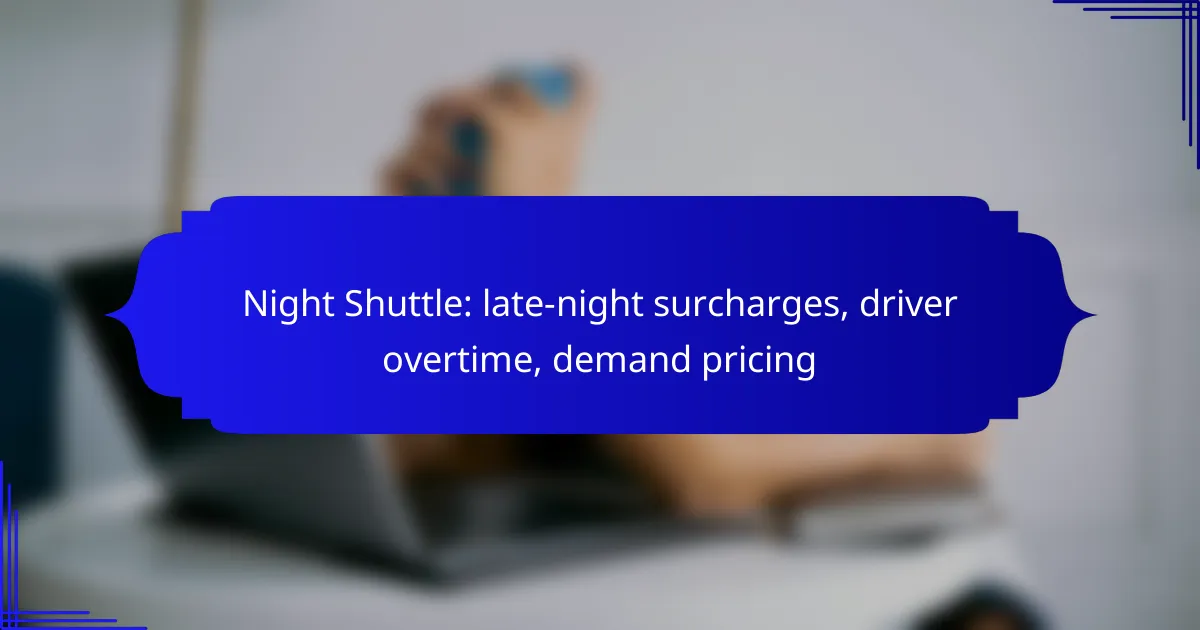Night shuttles in London often implement late-night surcharges during specific hours, resulting in increased fares to compensate drivers for their work during less desirable times. Additionally, driver overtime plays a crucial role in pricing, as higher operational costs from overtime pay can lead to elevated passenger fares. Demand pricing further complicates the fare structure, adjusting rates based on real-time demand to ensure availability while maximizing revenue for operators.

What are the late-night surcharges for night shuttles in London?
In London, late-night surcharges for night shuttles typically apply during specific hours, often resulting in higher fares. These surcharges are designed to compensate drivers for working during less desirable hours and to manage demand for late-night transport services.
Standard surcharge rates
The standard late-night surcharge for night shuttles in London usually ranges from 20% to 50% above the regular fare. This surcharge generally applies between midnight and 5 AM, reflecting the increased operational costs during these hours. Riders should check with their specific shuttle service for exact rates, as they can vary by provider.
Peak hour pricing
During peak late-night hours, particularly on weekends, night shuttle prices can increase significantly due to high demand. Some services implement dynamic pricing strategies, where fares may rise based on the number of requests. Riders can expect to pay up to 100% more during these peak times compared to standard rates.
Discounts for frequent riders
Many night shuttle services in London offer discounts for frequent riders, which can help mitigate the impact of late-night surcharges. These discounts may come in the form of loyalty programs or bulk purchase options, allowing regular users to save on their overall travel costs. Riders should inquire about available programs to maximize savings on late-night trips.

How does driver overtime affect night shuttle pricing?
Driver overtime significantly impacts night shuttle pricing by increasing operational costs, which can lead to higher fares for passengers. When drivers work beyond their standard hours, they are entitled to overtime pay, which is typically higher than regular rates.
Overtime pay rates
Overtime pay rates for drivers usually range from 1.5 to 2 times their standard hourly wage, depending on local labor laws and company policies. For instance, if a driver earns $15 per hour, their overtime rate could be between $22.50 and $30 per hour. This increase in pay is a crucial factor that shuttle companies must account for when setting prices during late-night hours.
Impact on overall fare
The inclusion of overtime pay in the cost structure can lead to noticeable increases in overall fares for night shuttle services. Passengers may see surcharges added to their base fare during late-night trips, often ranging from 10% to 30% more than standard rates. This pricing adjustment reflects the additional costs incurred by the company to compensate drivers fairly for their extended hours.
To avoid surprises, passengers should check for any late-night surcharges before booking their rides. Understanding how driver overtime affects pricing can help riders make informed decisions about their travel options during late-night hours.
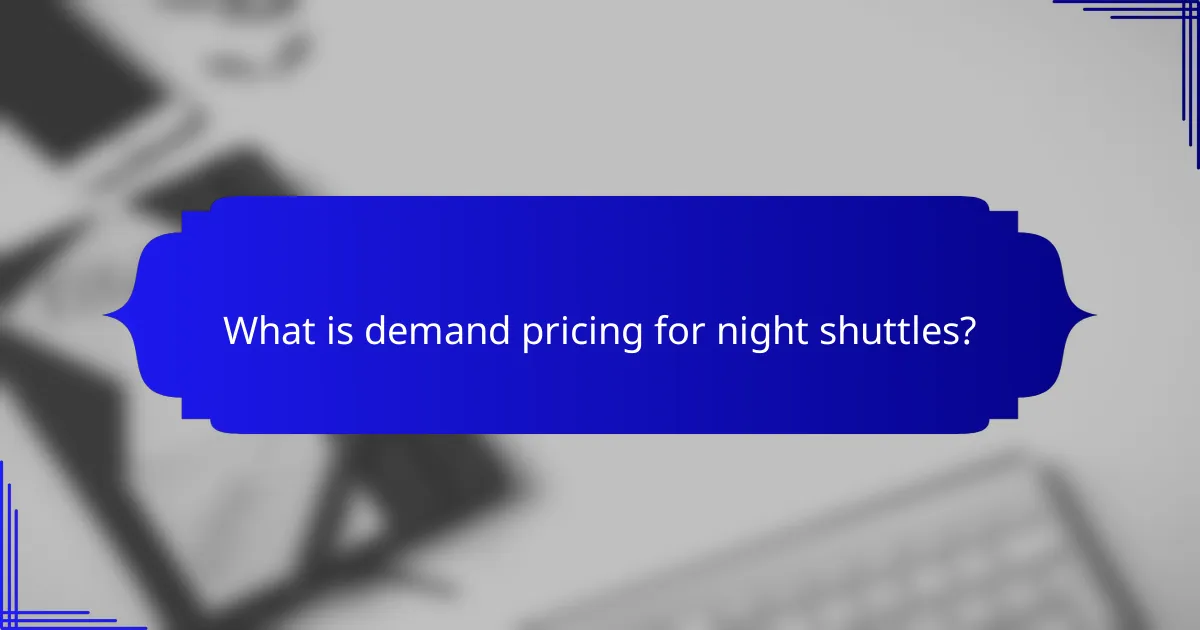
What is demand pricing for night shuttles?
Demand pricing for night shuttles refers to the variable fare structure that adjusts based on real-time demand for services during late-night hours. This pricing strategy aims to balance supply and demand, ensuring that shuttles are available when needed while maximizing revenue for operators.
Dynamic pricing models
Dynamic pricing models for night shuttles utilize algorithms to adjust fares based on factors such as current demand, time of day, and historical usage patterns. For instance, during peak hours or special events, prices may increase significantly, while off-peak times may see lower rates to attract more riders.
Operators often implement surge pricing, where fares can rise by a certain percentage when demand spikes. This approach encourages more drivers to be available during busy periods, helping to meet rider needs effectively.
Factors influencing demand pricing
Several factors influence demand pricing for night shuttles, including local events, weather conditions, and time-sensitive needs of passengers. For example, a concert or sporting event can lead to a sudden increase in demand, prompting higher fares.
Additionally, driver availability and overtime considerations play a crucial role. If fewer drivers are on duty late at night, prices may rise to incentivize more drivers to work during those hours. Understanding these factors can help riders anticipate fare changes and plan their travel accordingly.
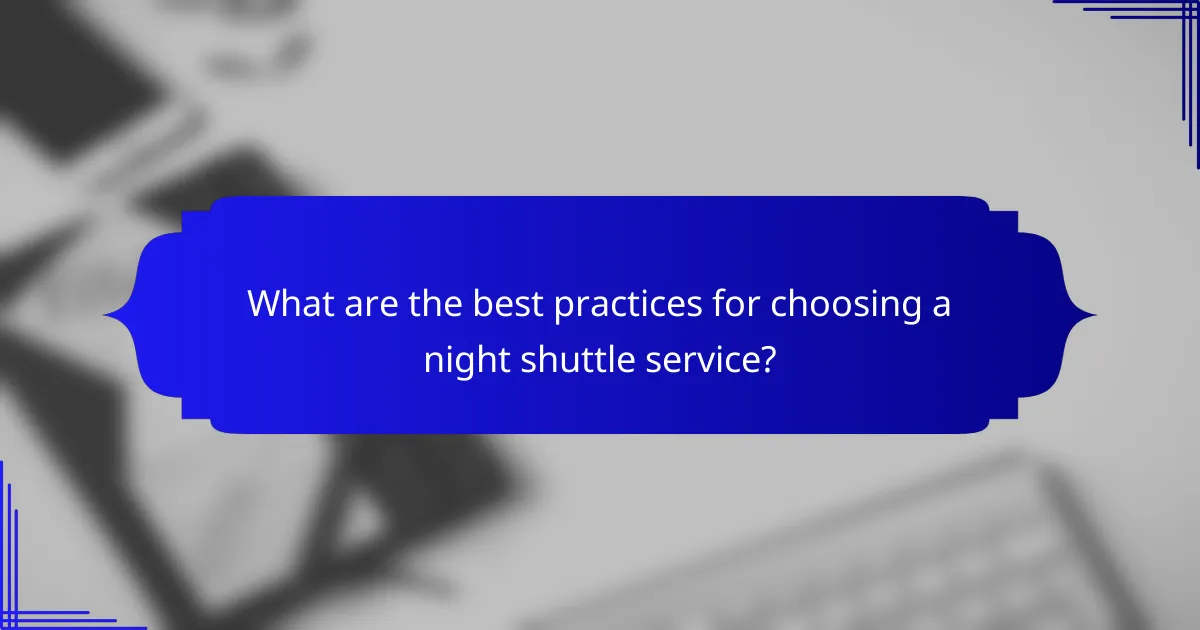
What are the best practices for choosing a night shuttle service?
Choosing a night shuttle service involves assessing reliability, pricing, and overall value. Focus on services that offer clear communication, transparent pricing, and a good track record of punctuality.
Evaluating service reliability
Service reliability is crucial for night shuttle operations, especially during late hours when demand may fluctuate. Look for companies with positive customer reviews and a history of on-time performance. Consider services that provide real-time tracking, allowing you to monitor the shuttle’s location and estimated arrival time.
Check if the shuttle service has contingency plans for unexpected delays, such as traffic or weather issues. Reliable services often have backup drivers or vehicles to ensure that your ride is not canceled last minute.
Comparing pricing structures
Pricing for night shuttle services can vary significantly based on factors like demand, distance, and time of night. Some companies implement surge pricing during peak hours, while others may offer flat rates. It’s essential to compare these structures to find the most economical option for your needs.
When evaluating costs, consider any additional fees, such as late-night surcharges or driver overtime. Request a detailed breakdown of the pricing to avoid surprises. A good practice is to book in advance, as many services offer discounts for early reservations.
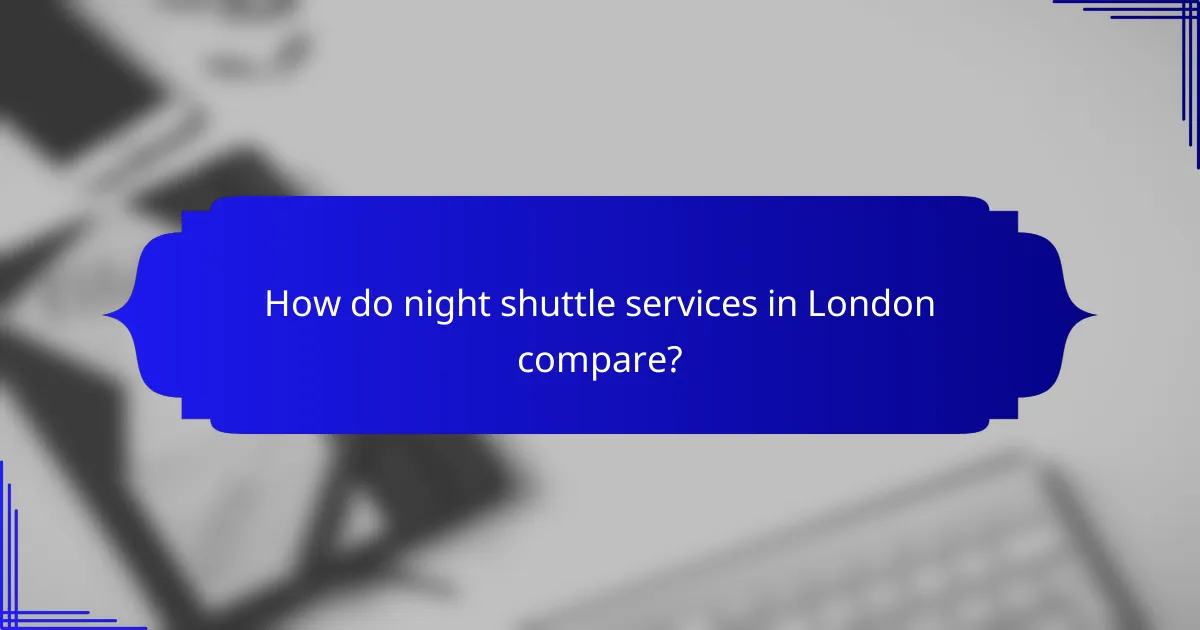
How do night shuttle services in London compare?
Night shuttle services in London vary significantly in terms of pricing, availability, and customer satisfaction. Factors such as late-night surcharges, driver overtime, and demand pricing play crucial roles in shaping the overall experience for users.
Service comparisons
When comparing night shuttle services in London, consider factors like service frequency, pricing structure, and vehicle types. Most services operate with a base fare that increases during peak hours, especially late at night, due to demand pricing. For example, fares can rise by 20-50% during busy periods, making it essential to check rates in advance.
Additionally, some companies may offer flat rates for specific routes, while others charge by the mile or minute. It’s advisable to compare these options to find the most cost-effective choice for your journey.
Customer reviews and ratings
Customer feedback on night shuttle services in London often highlights the importance of reliability and driver professionalism. Many users appreciate services that provide real-time tracking and prompt communication, which can enhance the overall experience. Ratings typically range from 3 to 5 stars, with higher scores reflecting better service consistency and vehicle cleanliness.
To gauge the best options, check online platforms for recent reviews and ratings. Look for patterns in customer experiences, such as frequent delays or issues with pricing transparency, to make an informed decision on which service to choose.
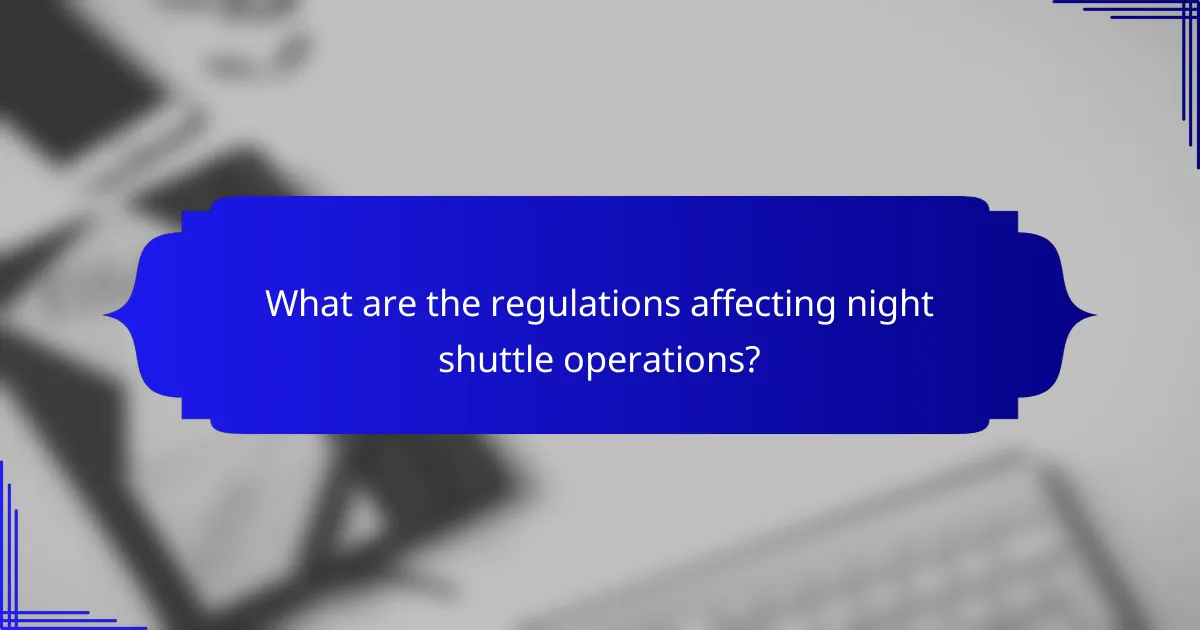
What are the regulations affecting night shuttle operations?
Night shuttle operations are subject to various regulations that ensure safety, fair pricing, and driver welfare. Key areas of focus include licensing requirements, driver working hours, and demand pricing strategies.
Licensing requirements
To operate a night shuttle service, companies must obtain specific licenses that comply with local transportation regulations. These licenses often require background checks, vehicle inspections, and proof of insurance. Depending on the region, additional permits may be necessary for operating during late-night hours.
For example, in the United States, many states mandate that shuttle services hold a commercial vehicle license, while in Europe, regulations may vary significantly between countries. Always check local laws to ensure compliance.
Driver working hour regulations
Driver working hour regulations are critical to maintaining safety and preventing fatigue. Many jurisdictions limit the number of hours a driver can operate a vehicle within a given time frame, often capping shifts at around 10-12 hours. Additionally, mandatory rest periods are typically enforced to ensure drivers are well-rested.
For instance, in the EU, drivers must adhere to rules that stipulate a maximum of 9 hours of driving per day, with breaks required after a certain period. Understanding these regulations helps shuttle operators manage schedules effectively and avoid penalties.
